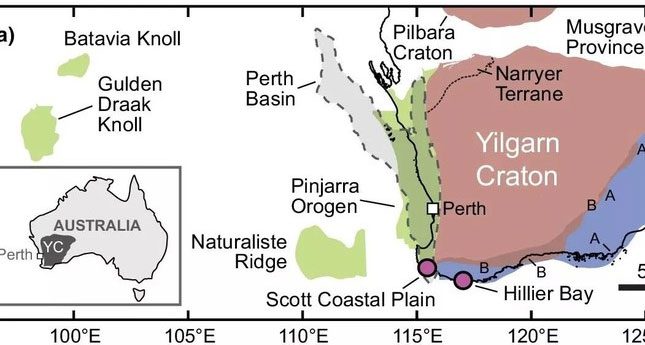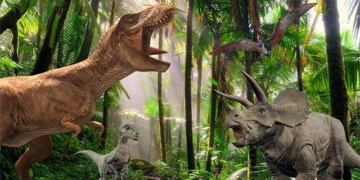A new study reveals that a 4 billion-year-old piece of Earth’s crust, roughly the size of Ireland, is hidden beneath Western Australia.
This crust is among the oldest on Earth, though not the oldest; that honor belongs to the Canadian Shield rocks along the eastern shore of Hudson Bay, which date back 4.3 billion years (Earth is approximately 4.54 billion years old). Due to continuous disruption and subduction of Earth’s crust by plate tectonics, most of the planet’s rock surface has formed within the last few billion years.

Geological map of Western Australia, showing the location of the Scott Coastal Plain, where the ancient 4 billion-year-old crust was discovered.
However, the oldest crust ever discovered, similar to the newly found crust in Australia, is around 4 billion years old. Co-author of the study, Maximilian Droellner, a researcher at Curtin University in Australia, noted that something significant occurred during that era in Earth’s history.
Droellner stated: “When comparing our findings with existing data, it appears that many regions around the world underwent similar formation and preservation of primordial crust. This suggests a significant change in Earth’s evolutionary process about four billion years ago, when meteorite bombardment decreased, crust stabilized, and life on Earth began to form.”
The ancient crust is concealed near where some of the oldest minerals on Earth have been previously discovered. At Jack Hills in Australia, researchers found tiny zircon minerals dated to 4.4 billion years. These minerals have survived even as the rocks that once contained them have eroded. The surrounding rocks at Jack Hills, known as the Narryer Terrane, date back to around 3.7 billion years.
Geochemical hints in sediment layers near this area suggest that there may be even older crust buried beneath newer rock and sediment layers at the surface. Therefore, Droellner and colleagues decided to examine zircons in sediment from the Scott Coastal Plain, south of Perth. The sediment layers on this plain have eroded from deeper rocks on the Australian continent.
After using laser beams to analyze its age, the rocks containing these minerals were determined to have formed between 3.8 billion and 4 billion years ago.
To learn about the origins of these minerals, researchers turned to data collected by satellites orbiting Earth. Because Earth’s crust varies in thickness, gravitational forces change slightly across the planet’s surface. By measuring these gravitational variations, scientists can infer the thickness of the crust at different locations and hypothesize where the ancient crust might be buried.
In their paper, published online on June 17 in the journal Terra Nova, the researchers stated that it is buried tens of kilometers beneath the surface. They found that the boundaries of this ancient crust are associated with gold and iron ore deposits, indicating the significance of this very old crust in controlling the formation of rocks and minerals in the region.
The researchers wrote: “Understanding the formation of Earth’s crust 4 billion years ago could help researchers comprehend how continents formed for the first time. This era laid the groundwork for the planet as we know it today, but very few clues about the earliest Earth have survived the continuous upheaval of the planet’s surface. This crust has endured through numerous mountain-forming events between Australia, India, and Antarctica.”





















































